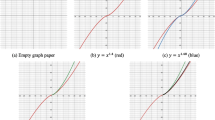Abstract
This is a report of a study of students’ understanding of infinite series. It has a three-fold purpose: to show that students may construct two essentially different notions of infinite series, to show that one of the constructions is particularly difficult for students, and to examine the way in which these two different constructions may be built so that we may uncover ways to help students improve their understanding. The theoretical framework consists of action–process–object–schema theory and the specific model of conceptions in Balacheff’s theory of conception, knowing, and concept. Approaching the problem from these two different theoretical perspectives allows us to provide different and at the same time complementary explanations of observed phenomena. The two different infinite series constructions are, briefly stated, series as an infinite unending process of addition and series as a sequence of partial sums. Students are found to have difficulty building an understanding of series as a sequence of partial sums and thus tend to have difficulty in problem situations that require this interpretation. The study uses semi-structured interviews with 10 graduate students. The interviews explore situations that might give insight into students’ notion of the sequence of partial sums.
Similar content being viewed by others
Notes
In this question we first defined S to be the "sum" of the series, then gave two arguments giving different values for S, and referred to these two different "results" for S just prior to asking the question.
References
Asiala, M., Brown, A., DeVries, D. J., Dubinsky, E., Mathews, D., & Thomas, K. (1996). A framework for research and development in undergraduate mathematics education. In J. Kaput, E. Dubinsky, & A. H. Schoenfeld (Eds.), Research in collegiate mathematics education II (pp. 1–32). Providence, RI: American Mathematical Society.
Bagni, G. T. (2000). Difficulties with series in history and in the classroom. In J. Fauvel & J. van Maanen (Eds.), History in mathematics education: The ICMI study (pp. 82–86). Dordrecht, the Netherlands: Kluwer.
Bagni, G. T. (2005). Infinite series from history to mathematics education. International Journal for Mathematics Teaching and Learning [on-line journal], posted June 30, 2005, University of Plymouth, U.K. http://cimt.plymouth.ac.uk/journal/default.htm.
Bagni, G.T. (2007). Didactics and history of numerical series, 100 years after Ernesto Cesaro’s death (1906): Guido Grandi, Gottfried Wilhelm Leibnitz and Jacobo Riccati. Retrieved from http://www.syllogismos.it/history/GrandiJointMeeting.pdf.
Baker, B., Cooley, L., & Trigueros, M. (2000). The schema triad—a calculus example. Journal for Research in Mathematics Education, 31, 557–578.
Balacheff, N., & Gaudin, N. (2002). Student conceptions: An introduction to a formal characterization. Les Cahiers du Laboratoire Leibnitz n°65. http://www-leibniz.imag.fr/LesCahiers/Cahiers2002.html. Accessed 13 March 2012.
Czarnocha, B., Dubinsky, E., Prabhu, V., & Vidakovic, D. (1999). One theoretical perspective in undergraduate mathematics education research. In O. Zaslavsky (Ed.), Proceedings of the 23rd conference of the International Group for the Psychology of Mathematics Education (Vol. 1, pp. 95–110). Haifa, Israel: PME.
Dubinsky, E. (1991). Reflective abstraction in advanced mathematical thinking. In D. Tall (Ed.), Advanced mathematical thinking (pp. 95–123). Dordrecht, the Netherlands: Kluwer.
Dubinsky, E. (1994). A theory and practice of learning college mathematics. In A. Schoenfeld (Ed.), Mathematical thinking and problem solving (pp. 221–243). Hillsdale, NJ: Erlbaum.
Fishbein, E., Tirosh, D., & Melamed, U. (1981). Is it possible to measure the intuitive acceptance of a mathematical statement? Educational Studies in Mathematics, 12, 491–512.
Kline, M. (1972). Mathematical thought from ancient to modern times (Vol. 3). New York: Oxford University Press.
Mamona, J. C. (1990). Sequences and series—sequences and functions: students’ confusions. International Journal of Mathematical Education in Science and Technology, 21, 333–337.
McDonald, M. A., Mathews, D., & Strobel, K. (2000). Understanding sequences: A tale of two objects. In E. Dubinsky, A. H. Schoenfeld, & J. Kaput (Eds.), Research in collegiate mathematics education IV (pp. 77–102). Providence, RI: American Mathematical Society.
Miyakawa, T. (2004). Reflective symmetry in construction and proving. In M. J. Høines & A. B. Fuglestad (Eds.), Proceedings of the 28th conference of the International Group for the Psychology of Mathematics Education (Vol. 3, pp. 337–344). Bergen, Norway: PME.
Piaget, J., & García, R. (1983). Psicogénesis e historia de la ciencia [Psychogenesis and history of science]. Mexico City, Mexico: Siglo XXI Editores.
Przenioslo, M. (2006). Conceptions of a sequence formed in secondary school. International Journal of Mathematical Education in Science and Technology, 37(7), 805–823.
Sierpińska, A. (1987). Humanities students and epistemological obstacles related to limits. Educational Studies in Mathematics, 18(4), 371–397.
Acknowledgments
The authors wish to thank Professor Ed Dubinsky for his guidance and many insightful comments. His collaboration in the project was made possible by a RUME mentoring grant of the Exxon/Mobil Education Foundation. The authors also thank the referees of previous versions of this paper for their many valuable comments.
Author information
Authors and Affiliations
Corresponding author
Electronic supplementary materials
Below is the link to the electronic supplementary material.
ESM 1
(DOC 30 kb)
Rights and permissions
About this article
Cite this article
Martínez-Planell, R., Gonzalez, A.C., DiCristina, G. et al. Students’ conception of infinite series. Educ Stud Math 81, 235–249 (2012). https://doi.org/10.1007/s10649-012-9401-2
Published:
Issue Date:
DOI: https://doi.org/10.1007/s10649-012-9401-2




